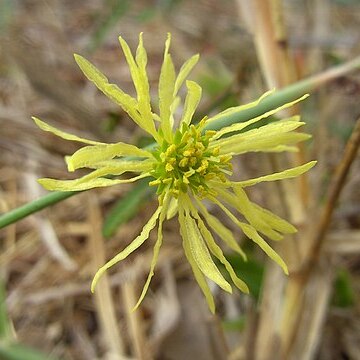Perennial, terrestrial, prostrate or weakly ascending herb; all parts pubescent or nearly glabrous. Taproot thick, becoming woody. Stems to 0.45 m, terete, angled when young. Stipules persistent, lanceolate, acuminate, membranaceous, 4.5-9 by 1.5-3 mm, faintly nerved; margins ± ciliate. Leaves: petiole 0.8-3 cm, angled, glandless or with an obscure gland at the junction of the proximal pair of pinnae; rachis angled, without glands; pinnae 2-4(-6) pairs, winged, pubescent or sparsely ciliate; leaflets 7-22 pairs per pinna, oblong, obtuse, broadly acute or occasionally mucronulate, asymmetrical, 3.5-11.1 by 0.8-2.6 mm, minutely ciliate on the margin, the surface appearing minutely punctate, venation raised, reticulate. Inflorescence: peduncles 4-13.5 cm, usually with two bracts, 3-7.1 mm, distributed evenly along the axis, caducous; spikes globoid in bud, 15-35-flowered. Lower flowers sterile: calyx green, campanulate, 0.7-1.2 mm; teeth acute 0.2-0.4 mm; petals green, elliptic, 1.6-2.6 cm; staminodes yellow, 1.5-12 mm. Upper flowers bixual: calyx green, campanulate, 1-1.9 mm; teeth acute, 0.3-0.6 mm, ciliate or entire; petals green, 1.8-3.1 mm; stamens white, 3.9-5, anthers exserted, yellow, 0.7-0.9 mm; ovary 1-1.3 mm, glabrous. Pod reddish brown-crimson, oblong, flat, membranaceous to coriaceous, glabrous or with sparse short pubescence, dehiscent at the margins, 1.5-2.3 by 0.5-0.8 cm, rounded to the stipe. Seeds 3-8 per pod, brown, ovoid-orbicular, compressed4-4.1 by 3.4-3.5 mm, areole open towards the hilum.
More
Prostrate, infrequently erect, perennial herb with branches less than 1 m long, glabrous or with some straight or ± twisted white hairs on vegetative parts. Leaves: stipules persistent, lanceolate to ovate, 2.5–10 mm long, 1.5–5 mm wide, with an acute to caudate-acuminate apex; leaf axes eglandular or with 1 or 2 glands; pinnae 1–4 (–6)-jugate, commonly subtended by pseudostipels 1–2.5 mm long; leaflets 8–22-jugate, oblong, apiculate, 3.5–10 mm long, 1–2.2 mm wide, ciliolate. Inflorescence axillary, ± globular; peduncles slender, (2–) 4–10 (–13.5) cm long, glabrous to villous, bearing 2 alternate, ovate, acute to acuminate, basally cordate bracts 2–9 mm long, 2–5.5 mm wide. Flowers yellow, glabrous; lower ones with calyx 0.7–1.2 mm long and petals 1.6–2.6 mm long; upper ones with calyx 1–1.9 mm long and petals 1.8–3.1 mm long. Pod strongly compressed, oblong, 12–30 mm long, 6–9 mm wide, glabrous or puberulous. Seeds 3–8, broadly obovate, 3.8–4.5 mm long, 3–3.5 mm wide, brown.

